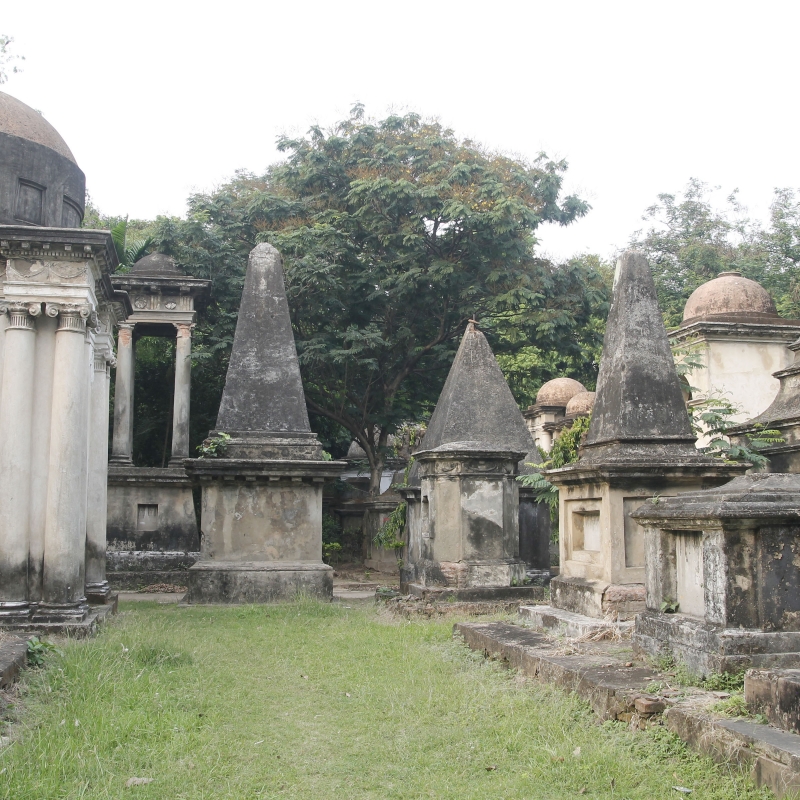The history of South Park Street cemetery is closely connected with the reconstruction of Calcutta (now Kolkata) after its recapture from the Nawab of Bengal, Siraj-ud-daula. But we need to go back to the early 18th century to learn why this famous cemetery was established where it stands today, on the corner of Park Street and Lower Circular Road in the area called Mullick Bazar.
Following the completion of old Fort William, a handsome church called St. Anne’s was consecrated in 1709. The church, with its high steeple and distinctive apse faced the east gate of the old fort. Its extensive grounds already held the two-storeyed octagonal tomb of Job Charnock, who had died in 1693. This is the earliest known English funerary structure in the city and it is surrounded today by flat tombstones of the first Calcutta inhabitants, some of their inscriptions in Latin.
Following Charnock’s consolidation of three small villages to form the basis of Calcutta, the East India Company created a successful trading port. The new Nawab of Bengal resented and feared this expansion by foreigners, hence his attack on the town. The proximity of St Anne’s Church was exploited by Siraj-ud-daula’s soldiers who could fire directly into the fort from the openings in its steeple. Calls to demolish the church and surrounding houses came too late to save the fort which was captured in June 1756 after fierce fighting. The Mahratta Ditch, dug some 40 years earlier around the city as a defensive measure against the Marathas, and its numerous palisades, had proved useless. The Nawab and his men simply marched down the Chitpore Road to Fort William. The bodies of those who died in the subsequent ‘Black Hole’ incident were thrown unceremoniously by the Nawab’s men into a defensive, but useless, ditch put up across The Avenue, the wide street that ran in front of today’s Writers’ Buildings.
After Robert Clive’s recapture of Calcutta, radical plans were implemented to ensure the city would not fall into enemy hands again. And it should be said that it was not just the Nawab or the Mahrattas (Marathas) who were seen as a threat, but other East India Companies too, the French in particular.
St Anne’s Church, badly damaged, was subsequently demolished and this left the East India Company without a place of worship. A Portuguese church was borrowed, and a room within what remained of the old fort was also used. But this meant that there was now no church with attached graveyard. Prominent victims of Clive’s triumphant recapture of Calcutta, like Admiral Watson, were buried next to Job Charnock’s tomb, which must have been a forlorn site with the ruins of the blackened church to one side. We do not know where the Protestant dead were buried between the recapture of the city in 1757 and the establishment of the cemetery known today as South Park Street cemetery in 1767. Clearly deaths did occur during this period—mortality rates among Europeans were so high that it was sometimes said the life of an Englishman, or woman, was ‘two monsoons’ or two years at most. There are occasional reports of ‘garden burials’ but it was clear something else was needed.
The Mahratta ditch is believed to have followed the line of today’s Lower Circular Road and the new cemetery was tucked just inside it. The ditch had quickly become a dumping ground for rubbish and dead animals, as ditches often do when their original purpose has gone. The site chosen for the cemetery was some way from the heart of British Calcutta yet still within walking distance. It was approached through marshy land with bamboo and trees growing thickly on either side of the raised path, which was called Burying Ground Road (Cotton 1980:68)[1] Only later, with the establishment of a deer park by Sir Elijah Impey, did the road become known as Park Street.
Because there was no Protestant church at the time around which a graveyard could grow, a decision was taken (probably by the Governor of the time, Sir Robert Clive) to establish a new kind of burial ground, one which was not dependent on a place of worship and was far enough out of town not to pose any threat of contamination to the natural springs in Tank Square. This meant that the first funerals would be conducted in whatever temporary room or borrowed chapel was available in central Calcutta. The funeral procession would then proceed down Chowringhee, still a tiger-infested area to the south, before turning sharply left along Burying Ground Road. The cortege, lit by torches of oil-soaked rags on poles, usually made its melancholy journey at night. It was thought too demoralising for the British residents to see their fellow countrymen and women borne with distressing frequency to their last resting places.
Although today South Park Street appears well-ordered with its broad, well-kept paths and impressive tombs fronting these paths, in fact the earliest burials, starting in 1768, tended to be jumbled together without any discernable pattern. Family graves would usually be placed near each other, forming a distinct cluster of tombs, but others appear to be placed in fairly random order. Cemeteries fill up first from the main entrance, where the oldest tombs are usually found. In this case the entrance was on Park Street. Later, as more room was needed, the cemetery was extended, both southwards and eastwards, with another entrance on Rawdon Road. These two extensions contain tombs in regular rows, quite different from the haphazard arrangements in the original burying ground.

Row of Graves at South Park Street Cemetery
Before examining some of the tombs it is important to place the cemetery in context. Although the first to be established here, it was followed by others so that the whole of this area formed a very substantial European necropolis. On the north side of Park Street was the Roman Catholic cemetery known as Tiretta’s Burying Ground, after the Italian who bought it to lay his young wife in. Sometimes called the French cemetery, it was opened about 1798. When it was cleared in 1977, some of the tombstones were rescued and placed in South Park Street cemetery. Adjacent to the Catholic cemetery was North Park Street cemetery, cleared in the 1950s. Across the road, to the east, and therefore outside the old Mahratta Ditch is Lower Circular Road cemetery, established in 1840 and still an open cemetery. Nearby is the Scottish cemetery, opened in 1820 and currently undergoing substantial restoration.
The Englishwoman Sophia Goldborne, describes the ‘Bengal burying grounds’ in 1785: ‘Obelisks, pagodas, etc., are erected at great expense and the whole spot is surrounded by as well-turned a walk as you traverse in Kensington Gardens, ornamented by a double row of aromatic trees, which afford a solemn and beautiful shade…I quitted them with unspeakable reluctance.’ (Cotton 1980:462) An anonymous author writing in 1811 had a different opinion: ‘I hate the grounds with pyramids oppressed, Where ashes moulder in sepulchral rest’ (Cotton 1980). This was not strictly true, because cremation for Europeans was highly unusual at the time. It was bodies that were buried, not ashes.
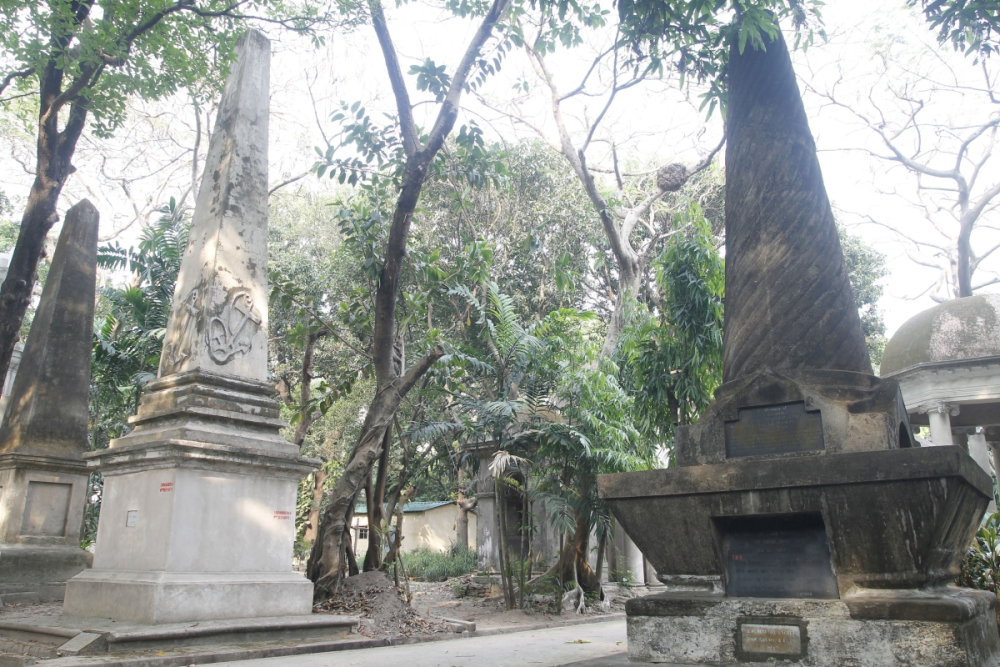
Pyramid shaped gravestones at South Park Street Cemetery
Certainly there were plenty of pyramids, obelisks and even pagodas, the descriptive word of the day for domed tombs supported by columns. A number of people have remarked on the fact that nowhere in South Park Street cemetery do we find any symbols of Christianity—no crosses or weeping angels or even gothic decoration, which were later to become associated with tombs. In the absence of any contemporary explanation, other than to record the grandiose funerary monuments, we can put forward two arguments.
The Age of Enlightenment, as it is called, dominated European thinking in the 18th century and some would argue that it had its roots in 17th-century England. It led to a deliberate move away from established religion and the dominance of the church. People became interested in the natural world around them, in new scientific discoveries and above all in a new climate of reason and rationality. The individual, freed from medieval shackles of an eternally vengeful god and a feudal way of life, became open to different influences. There was a sudden and deep fascination with the ancient classical world of Greece, Rome and Egypt, fuelled by archaeological discoveries and the Grand Tour, which rich young men would take on the European continent and through Italy in particular. D’Hancarville’s four volumes on a Collection of Etruscan, Greek and Roman Antiquities published in 1767 fostered the taste for neo-classicism which found a response among the more thoughtful Britons in Calcutta.
The domed ‘chhatris’ with their Ionic or Doric columns harked back to Piranesi’s vividly imagined Appian Way in Italy. Funerary urns were the classical symbol of Roman cremation where the urn would be covered with a draped cloth representing a shroud. Catafalques were erected standing on substantial square plinths and fluted broken columns symbolized a life cut short. Pyramids and obelisks reflected the pure lines of ancient Egyptian funerary monuments, grandiose in conception, but at the same time, simple and powerful.
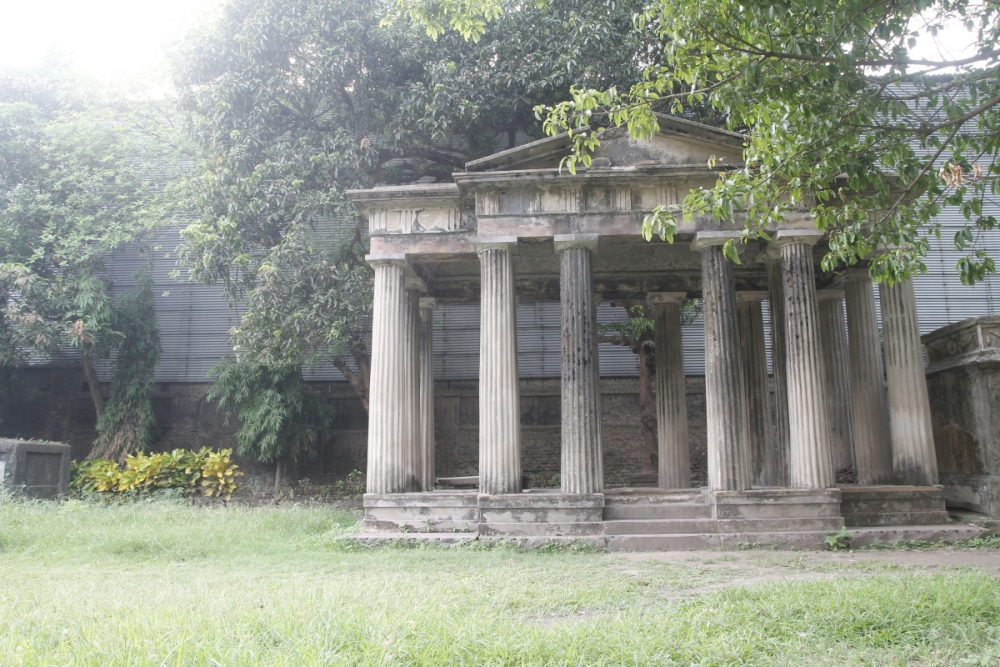
Doric columns at South Park Street Cemetery
Comparisons have been made between the British in India and the Romans in Britain. Both were invaders, initially after trade and conquest, but bringing to their colonies technology, buildings, roads, military cohesion, law and a new system of administration. British admirers of Calcutta in the late 18th century said that its handsome mansions, gleaming white in the sun, reminded them of Greece or Rome. This was a pleasing fancy for the Company men, who would end their days, if unlucky, under a suitable Roman-style tomb in Calcutta.
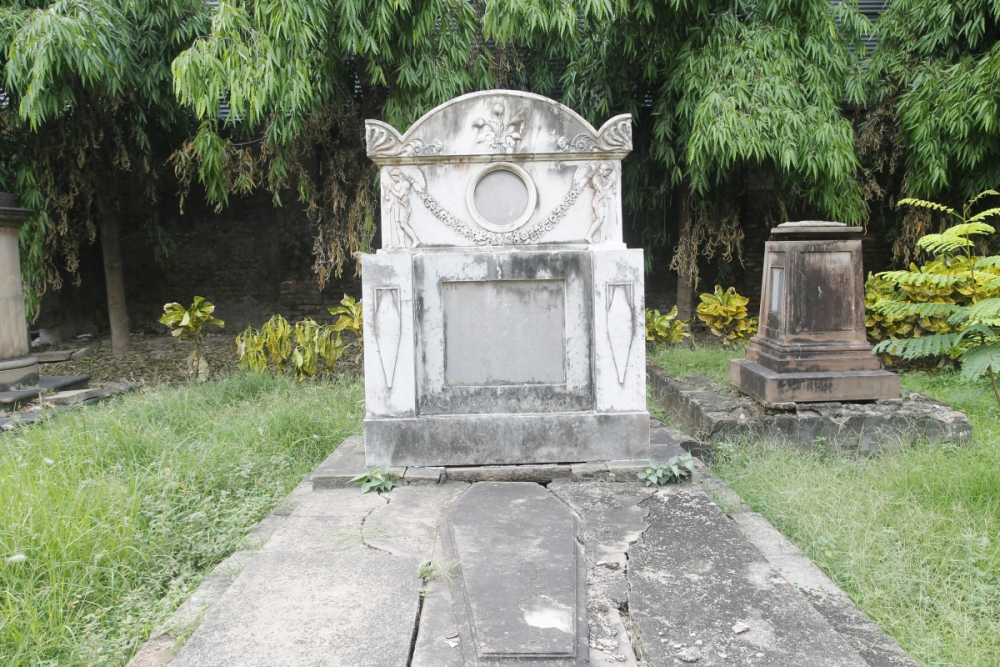
Roman Urns on an Unknown Grave
But this doesn’t quite explain the extraordinary size and ostentation of some of the tombs. The reason was that both labour and materials, were extremely cheap in Bengal compared to what they were in England. Even a master mason received only a few rupees a month, and bricks were so abundant that they could be pulverized to form an element of the ubiquitous lime mortar. Certainly if men like Sir William Jones, and women like Rose Aylmer had died in their native country they would not have been able to afford the extravagant tombs we see here. All of the often enormous structures in South Park Street were created not from marble or stone, as their originals would have been, but from small baked bricks covered with stucco. Some of the finials were strengthened with iron rods, now apparent when the brickwork fails.
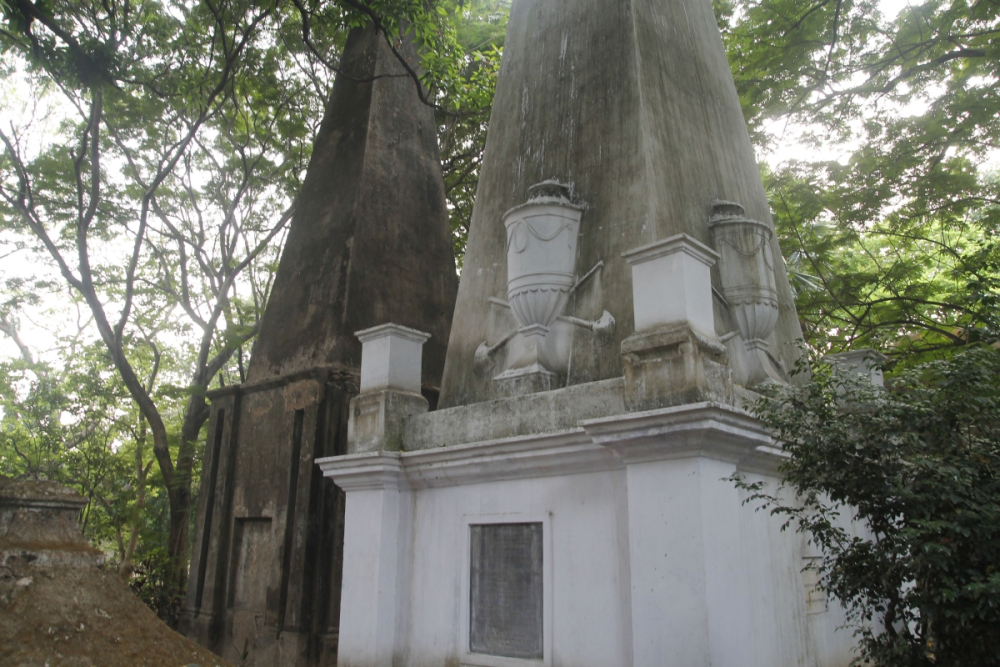
Tomb of William Jones
The tombs were to provide inspiration for future generations and many British burial grounds outside Bengal, like Varanasi, for example, have similar monuments, although because Calcutta was the capital of Company rule, provincial monuments are proportionally somewhat less grand. There is a distinct difference between these tombs and those of other Europeans in the Indian sub-continent and this has much to do with the date of its establishment. Earlier British tombs, at Surat, for example, followed the pattern of the Muslim maqbara, a square domed shrine, with columns and finials. These were tombs of wealthy men, but as we have seen in St John’s Churchyard, early citizens of Calcutta were content with a simple inscribed basalt slab. It was the confidence that arose from the realisation by Britons of their increasing importance in India, fuelled by Enlightenment ideas that led to these grandiose tombs at this particular moment in time.
The 18th-century Dutch cemetery of Cossimbazar has a characteristic double-storeyed tomb, not dissimilar to that of an early Dutch settler in the Narinda cemetery at Dhaka. At Chinsura, which changed hands several times between the Dutch and the English Companies, there is an interesting mixture of tombs which allow comparisons between architecture of the two nations. Not until the English Evangelical movement of the early 19th century, do tombs start to shrink and become more humble, more ‘Christian’ in their symbolism and more homogenous with those of other Europeans. By the time South Park Street closed to burials in 1830 (not 1790 as the plaque on the gatepost would have it), the assurance, and indeed pomposity that had characterized the early British merchants, officials, sailors, soldiers, judges, businessmen, rogues and the occasional eccentric like Hindoo Stuart, had gone.
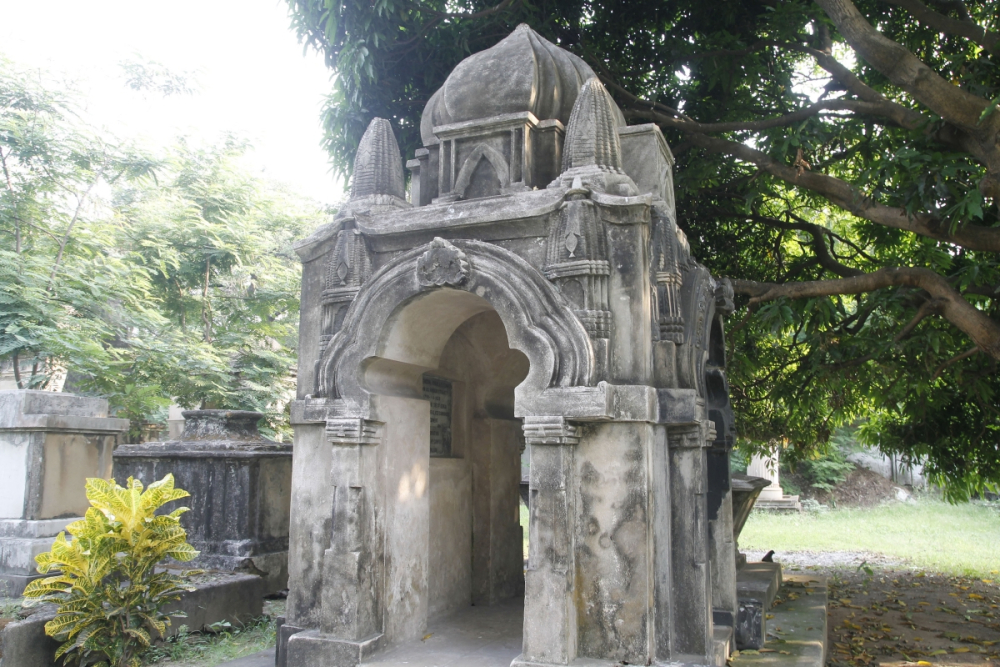
Tomb of Hindoo Stuart
Père Lachaise in Paris may claim to be the most visited non-church cemetery in Europe, but it is a comparative newcomer (opened in 1804) against South Park Street. The vivid stories associated with many of the dead buried in Calcutta and their extraordinary tombs means that this is still one of the most awe-inspiring places in India to visit. It is now firmly established on the itinerary of foreign tour groups and is supported by various charitable groups including the British Association for Cemeteries in South Asia (BACSA), which is based in London.
Glossary
Steeple: a church tower
Apse: A large semi-circular or polygonal recess inside a church with an arched or doomed roof.
Palisades: A fence of wooden stakes or iron railings fixed in the ground.
Obelisks: A tapering stone pillar which typically has a square or rectangular cross section.
Sepulchre: A small monument, cut in rock or built of stone, in which a dead person is laid or buried.
Doric: Relating to the oldest order of the classical Greek style of architecture which is characterized by a sturdy fluted column and a thick square at the top called the abacus which rests on a rounded moulding.
Ionic: Relating to the classical Greek style of architecture which is characterized by column with scroll shapes on either side of the capital.
Catafalques: A decorated wooden framework supporting the coffin of a distinguished person during a funeral.
Finial: A distinctive section or ornament at the apex of a roof, canopy, etc. on a building.
[1] Cotton, H.E.A. 1980 (Revised edition) Calcutta Old and New: A Historical and Descriptive Handbook to the City (Calcutta: W.Newman ).Cotton says the ‘melancholy name of Burying Ground Road’ first appears in Aaron Upjohn’s map of Calcutta dated 1793.
